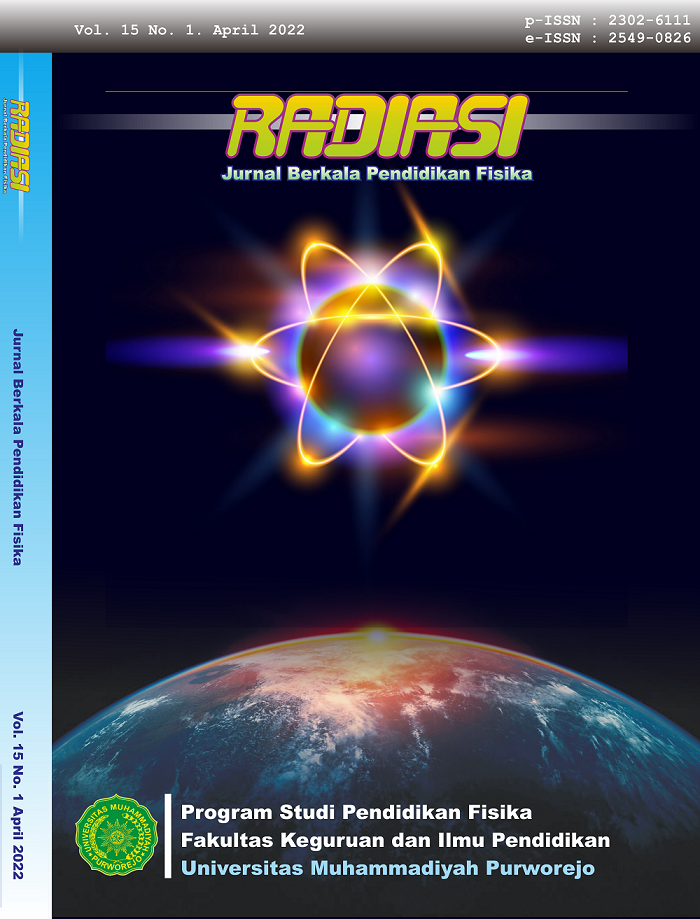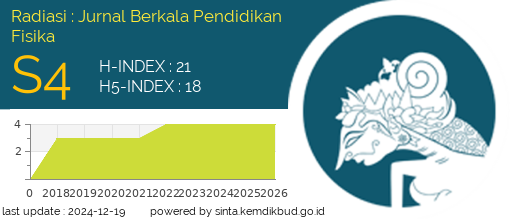Analysis of Attitudes and Approaches to Problem Solving: Gender Differences and Education Levels
Abstract
The main problem in this research is the low ability of students to solve physics problems. Students' attitudes and approaches to problem-solving are allegedly related to the way they study physics and their success in solving physics problems. This study demonstrated student attitudes and approaches to solving physics problems using Attitudes and Approaches to Problem Solving (AAPS) survey questions using quantitative methods. Data were collected from 1045 students. Data analysis was carried out by grouping the data by gender and education level. The t-test was used to see the differences in each group. The result showed no statistically significant differences between men and women (t = -1,65 dan Sig. = 0,098 > 0,05). In addition, there was a significant difference in the level of education between collect students with junior and senior high school education levels (p < 0.05). The implications for practice, and the directions for future research are discussed.
Downloads
References
S. R. Manurung and D. D. Panggabean, “Improving students’ thinking ability in physics using interactive multimedia based problem solving,” Cakrawala Pendidik., vol. 39, no. 2, pp. 460–470, Jun. 2020.
B. Hegde and B. N. Meera, “How do they solve it? An insight into the learner’s approach to the mechanism of physics problem solving,” Phys. Rev. Spec. Top. - Phys. Educ. Res., vol. 8, no. 1, pp. 1–9, 2012.
W. K. Adams, K. K. Perkins, N. S. Podolefsky, M. Dubson, N. D. Finkelstein, and C. E. Wieman, “New instrument for measuring student beliefs about physics and learning physics: The Colorado Learning Attitudes about Science Survey,” Phys. Rev. Spec. Top. - Phys. Educ. Res., vol. 2, no. 1, p. 010101, Jan. 2006.
E. F. Redish, J. M. Saul, and R. N. Steinberg, “Student expectations in introductory physics,” Am. J. Phys., vol. 66, no. 3, pp. 212–224, Mar. 1998.
C. A. Ogilvie, “Changes in students’ problem-solving strategies in a course that includes context-rich, multifaceted problems,” Phys. Rev. Spec. Top. - Phys. Educ. Res., vol. 5, no. 2, p. 020102, Aug. 2009.
L. N. Walsh, R. G. Howard, and B. Bowe, “Phenomenographic study of students’ problem solving approaches in physics,” Phys. Rev. Spec. Top. - Phys. Educ. Res., vol. 3, no. 2, pp. 1–12, 2007.
E. F. Redish, “Changing student ways of knowing: What should our students learn in a physics class?,” in Proceedings of World View on Physics Education 2005: Focusing on Change, 2005, pp. 1–13.
Haeruddin, Z. K. Prasetyo, and Supahar, “The development of a metacognition instrument for college students to solve physics problems,” Int. J. Instr., vol. 13, no. 1, pp. 767–782, 2020.
A. Mason and C. Singh, “Surveying graduate students’ attitudes and approaches to problem solving,” Phys. Rev. Spec. Top. - Phys. Educ. Res., vol. 6, no. 2, p. 020124, Dec. 2010.
J. Marx and K. Cummings, “What factors really influence shifts in student’s attitudes and expectations in an introductory physics course?,” in AIP Conference Proceedings, 2007, vol. 883, no. 1, pp. 101–104.
A. Elby, “Helping physics students learn how to learn,” Am. J. Phys., vol. 69, no. S1, pp. S54–S64, 2001.
K. E. Gray, W. K. Adams, C. E. Wieman, and K. K. Perkins, “Students know what physicists believe, but they don’t agree: A study using the CLASS survey,” Phys. Rev. Spec. Top. - Phys. Educ. Res., vol. 4, no. 2, p. 020106, Nov. 2008.
K. Cummings, “Attitudes Toward Problem Solving as Predictors of Student Success,” in AIP Conference Proceedings, 2004, vol. 720, no. 1, pp. 133–136.
N. Balta, A. J. Mason, and C. Singh, “Surveying Turkish high school and university students’ attitudes and approaches to physics problem solving,” Phys. Rev. Phys. Educ. Res., vol. 12, no. 1, Jan. 2016.
M. Good, A. Maries, and C. Singh, “Impact of traditional or evidence-based active-engagement instruction on introductory female and male students’ attitudes and approaches to physics problem solving,” Phys. Rev. Phys. Educ. Res., vol. 15, no. 2, Sep. 2019.
D. K. Pugalee et al., “Toward the development of a metacognition construct for communities of inquiry,” Metacognition Learn., vol. 9, no. 2, pp. 37–41, 2012.
M. S. Sabella and E. F. Redish, “Knowledge organization and activation in physics problem solving,” Am. J. Phys., vol. 75, no. 11, pp. 1017–1029, Nov. 2007.
E. Kim and S.-J. Pak, “Students do not overcome conceptual difficulties after solving 1000 traditional problems,” Am. J. Phys., vol. 70, no. 7, p. 759, Jun. 2002.
G. Pólya, How to Solve It: A New Aspect of Mathematical Method, Newer Edit. New Jersey: Princeton University Press, 2015.
L. Ivanjek, A. Susac, M. Planinic, A. Andrasevic, and Z. Milin-Sipus, “Student reasoning about graphs in different contexts,” Phys. Rev. Phys. Educ. Res., vol. 12, no. 1, p. 010106, 2016.
B. Ibrahim and N. S. Rebello, “Role of mental representations in problem solving: Students’ approaches to nondirected tasks,” Phys. Rev. Spec. Top. - Phys. Educ. Res., vol. 9, no. 2, pp. 1–17, 2013.
P.-F. Chang and M.-C. Lin, “Against All Odds: Problem-Solving Strategies and Behavioural Characteristics of Novice Students,” J. Furth. High. Educ., vol. 39, no. 3, pp. 293–319, 2015.
P. B. Kohl and N. D. Finkelstein, “Patterns of multipe representation use by experts and novices during physics problem solving,” Phys. Rev. Spec. Top. - Phys. Educ. Res., vol. 4, no. 1, pp. 1–13, 2008.
T. Gok, “The General Assessment of Problem Solving Processes and Metacognition in Physics Education,” Eurasian J. Phys. Chem. Educ., vol. 2, no. 2, pp. 110–122, 2010.
G. Taasoobshirazi and J. Farley, “Construct validation of the physics metacognition inventory,” Int. J. Sci. Educ., vol. 35, no. 3, pp. 447–459, 2013.
Haeruddin, Z. K. Prasetyo, Supahar, E. Sesa, and G. Lembah, “Psychometric and structural evaluation of the physics metacognition inventory instrument,” Eur. J. Educ. Res., vol. 9, no. 1, pp. 215–225, 2020.
G. Taasoobshirazi, M. Bailey, and J. Farley, “Physics metacognition inventory part II: Confirmatory factor analysis and rasch analysis,” Int. J. Sci. Educ., vol. 37, no. 17, pp. 2769–2786, 2015.
A. F. Heckler, “Some Consequences of Prompting Novice Physics Students to Construct Force Diagrams,” Int. J. Sci. Educ., vol. 32, no. 14, pp. 1829–1851, 2010.
T. Byun and G. Lee, “Why students still can’t solve physics problems after solving over 2000 problems,” Am. J. Phys., vol. 82, no. 9, p. 906, Aug. 2014.
E. Gaigher, J. M. Rogan, and M. W. H. Braun, “Exploring the Development of Conceptual Understanding through Structured Problem‐solving in Physics,” http://dx.doi.org/10.1080/09500690600930972, vol. 29, no. 9, pp. 1089–1110, Jul. 2007.
J. J. G. van Merriënboer, “Perspectives on problem solving and instruction,” Comput. Educ., vol. 64, pp. 153–160, May 2013.
N. Balta and M. A. Asikainen, “Introductory students’ attitudes and approaches to physics problem solving: Major, achievement level and gender differences,” J. Technol. Sci. Educ., vol. 9, no. 3, pp. 378–387, 2019.
M. Duran, “An Academic Survey Concerning High School and University Students’ Attitudes and Approaches to Problem Solving in Chemistry,” Int. J. Environ. Sci. Educ., vol. 11, no. 5, pp. 819–837, 2016.
J. Sirait, L. Sutrisno, N. Balta, and A. Mason, “The Development of Questionnaire to Investigate Students Attitudes and Approaches in Physics Problem Solving,” J. Pendidik. Fis. Indones., vol. 13, no. 2, pp. 79–87, Nov. 2017.
D. E. Beaton, C. Bombardier, F. Guillemin, and M. B. Ferraz, “Guidelines for the process of cross-cultural adaptation of self-report measures,” Spine (Phila. Pa. 1976)., vol. 25, no. 24, pp. 3186–3191, 2000.
A. Mason and C. Singh, “Surveying graduate students’ attitudes and approaches to problem solving,” Phys. Rev. Spec. Top. - Phys. Educ. Res., vol. 6, no. 2, Dec. 2010.
G. Frederick J and W. Larry B., Statistics for the behavioral sciences, 10th ed. Boston, MA: Cengage Learning, 2017.
A. J. Bishara and J. B. Hittner, “Testing the significance of a correlation with nonnormal data: Comparison of Pearson, Spearman, transformation, and resampling approaches,” Psychol. Methods, vol. 17, no. 3, pp. 399–417, Sep. 2012.
C. Singh and A. Mason, “Physics graduate students’ attitudes and approaches to problem solving,” AIP Conf. Proc., vol. 1179, no. 2009, pp. 273–276, 2009.
M. Fidan and M. Tuncel, “Integrating augmented reality into problem based learning: The effects on learning achievement and attitude in physics education,” Comput. Educ., vol. 142, Dec. 2019.
M. J. Cahill et al., “Understanding the relationship between student attitudes and student learning,” Phys. Rev. Phys. Educ. Res., vol. 14, no. 1, p. 010107, Feb. 2018.
Copyright (c) 2022 Haeruddin Haeruddin, Kamaluddin Kamaluddin, Amiruddin Kade, Albar Rabak Pabianan

This work is licensed under a Creative Commons Attribution-NonCommercial 4.0 International License.




